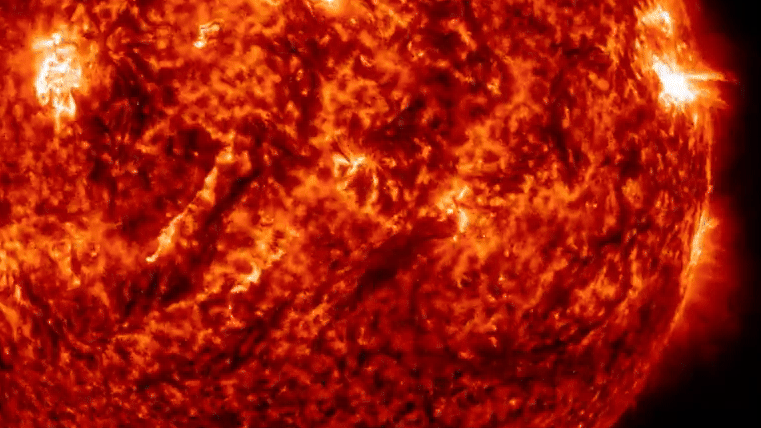'Einstein's Biggest Blunder' May Have Finally Been Fixed
The cosmological constant has plagued physicists for more than a century.

There is a fundamental problem in physics.
A single number, called the cosmological constant, bridges the microscopic world of quantum mechanics and the macroscopic world of Einstein's theory of general relativity. But neither theory can agree on its value.
In fact, there's such a huge discrepancy between the observed value of this constant and what theory predicts that it is widely considered the worst prediction in the history of physics. Resolving the discrepancy may be the most important goal of theoretical physics this century.
Lucas Lombriser, an assistant professor of theoretical physics at the University of Geneva in Switzerland, has introduced a new way of evaluating Albert Einstein's equations of gravity to find a value for the cosmological constant that closely matches its observed value. He published his method online in the Oct. 10 issue of the journal Physics Letters B.
Related: The Biggest Unsolved Mysteries in Physics
How Einstein's biggest blunder became dark energy
The story of the cosmological constant began more than a century ago when Einstein presented a set of equations, now known as the Einstein field equations, that became the framework of his theory of general relativity. The equations explain how matter and energy warp the fabric of space and time to create the force of gravity. At the time, both Einstein and astronomers agreed that the universe was fixed in size and that the overall space between galaxies did not change. However, when Einstein applied general relativity to the universe as a whole, his theory predicted an unstable universe that would either expand or contract. To force the universe to be static, Einstein tacked on the cosmological constant.
Nearly a decade later, another physicist, Edwin Hubble, discovered that our universe is not static, but expanding. The light from distant galaxies showed they were all moving away from each other. This revelation persuaded Einstein to abandon the cosmological constant from his field equations as it was no longer necessary to explain an expanding universe. Physics lore has it that Einstein later confessed that his introduction of the cosmological constant was perhaps his greatest blunder.
Get the Space.com Newsletter
Breaking space news, the latest updates on rocket launches, skywatching events and more!
In 1998, observations of distant supernovas showed the universe wasn't just expanding, but the expansion was speeding up. Galaxies were accelerating away from each other as if some unknown force was overcoming gravity and shoving those galaxies apart. Physicists have named this enigmatic phenomenon dark energy, as its true nature remains a mystery.
In a twist of irony, physicists once again reintroduced the cosmological constant into Einstein's field equations to account for dark energy. In the current standard model of cosmology, known as ΛCDM (Lambda CDM), the cosmological constant is interchangeable with dark energy. Astronomers have even estimated its value based on observations of distant supernovas and fluctuations in the cosmic microwave background. Although the value is absurdly small (on the order of 10^-52 per square meter), over the scale of the universe, it is significant enough to explain the accelerated expansion of space.
"The cosmological constant [or dark energy] currently constitutes about 70% of the energy content in our universe, which is what we can infer from the observed accelerated expansion that our universe is presently undergoing. Yet this constant is not understood," Lombriser said. "Attempts to explain it have failed, and there seems to be something fundamental that we are missing in how we understand the cosmos. Unraveling this puzzle is one of the major research areas in modern physics. It is generally anticipated that resolving the issue may lead us to a more fundamental understanding of physics."
Related: 8 Ways You Can See Einstein’s Theory of Relativity in Real Life
The worst theoretical prediction in the history of physics
The cosmological constant is thought to represent what physicists call "vacuum energy." Quantum-field theory states that even in a completely empty vacuum of space, virtual particles pop in and out of existence and create energy — a seemingly absurd idea, but one that has been observed experimentally. The problem arises when physicists attempt to calculate its contribution to the cosmological constant. Their result differs from observations by a mind-boggling factor of 10^121 (that's 10 followed by 120 zeroes), the largest discrepancy between theory and experiment in all of physics.
Such a disparity has caused some physicists to doubt Einstein's original equations of gravity; some have even suggested alternative models of gravity. However, further evidence of gravitational waves by the Laser Interferometer Gravitational-Wave Observatory (LIGO) have only strengthened general relativity and dismissed many of these alternative theories. Which is why instead of rethinking gravity, Lombriser took a different approach to solve this cosmic puzzle.
"The mechanism I propose does not modify Einstein's field equations," Lombriser said. Instead, "it adds an additional equation on top of Einstein's field equations."
The gravitational constant, which was first used in Isaac Newton's laws of gravity and now an essential part of Einstein's field equations, describes the magnitude of the gravitational force between objects. It is considered one of the fundamental constants of physics, eternally unchanged since the beginning of the universe. Lombriser has made the dramatic assumption that this constant can change.
In Lombriser's modification of general relativity, the gravitational constant remains the same within our observable universe but may vary beyond it. He suggests a multiverse scenario where there may be patches of the universe invisible to us that have different values for the fundamental constants.
This variation of gravity gave Lombriser an additional equation that relates the cosmological constant to the average sum of matter across space-time. After he accounted for the estimated mass of all the galaxies, stars and dark matter of the universe, he could solve that new equation to obtain a new value for the cosmological constant — one that closely agrees with observations.
Using a new parameter, ΩΛ (omega lambda), that expresses the fraction of the universe made of dark matter, he found the universe is made up of about 74% dark energy. This number closely matches the value of 68.5% estimated from observations — a tremendous improvement over the huge disparity found by quantum field theory.
Although Lombriser's framework might solve the cosmological constant problem, there’s currently no way to test it. But in the future, if experiments from other theories validate his equations, it could mean a major leap in our understanding of dark energy and provide a tool to solve other cosmic mysteries.
- From Big Bang to Present: Snapshots of Our Universe Through Time
- 11 Fascinating Facts About Our Milky Way Galaxy
- Big Bang to Civilization: 10 Amazing Origin Events
Originally published on Live Science.
Join our Space Forums to keep talking space on the latest missions, night sky and more! And if you have a news tip, correction or comment, let us know at: community@space.com.
Tim Childers was a freelance science journalist with a background in physics and science communication. He studied Physics at the University of Colorado Boulder, with his research focused on modeling the dynamics of the accretion disks surrounding black holes. He then went on to do an internship at the NASA Goddard Space Flight Center using his film talents to create videos, news stories, and interviews. Nowadays, Tim is an exceptionally curious data scientist who loves using data to tell stories to a diverse audience.










